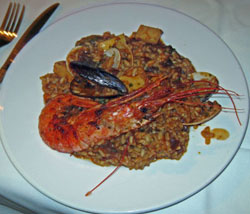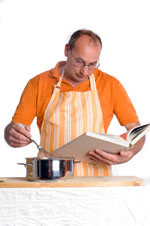 | . |
* Student will be able to accurately use regular and irregular tú form commands.
* Student will be able to identify in Spanish the major ingredients and tools needed to make a paella dish.
* Student will be able to explain the history of paella and describe the variety of paella dishes throughout Spain.
Paella is a Valencian rice dish that originated in its modern form in the mid-19th century near lake Albufera , a lagoon in Valencia, on the east coast of Spain . Many non-Spaniards view paella as Spain's national dish , but most Spaniards consider it to be a regional Valencian dish. Valencians, in turn, regard paella as one of their identifying symbols. According to tradition in Valencia, paella is cooked by men over an open fire, fueled by orange and pine branches along with pine cones. This produces an aromatic smoke which infuses the paella. Also, dinner guests traditionally eat directly out of the paellera.
There are three widely known types of paella: Valencian paella (Spanish: paella valenciana), seafood paella (Spanish: paella de marisco) and mixed paella (Spanish: paella mixta), but there are many others as well. Valencian paella consists of white rice , green vegatables , meat (rabbit, chicken, duck ), land snails , beans and seasoning. Seafood paella replaces meat and snails with seafood and omits beans and green vegetables. Mixed paella is a free-style combination of meat, seafood, vegetables, and sometimes beans. Most paella chefs use calasparra or bomba rices for this dish. Other key ingredients include saffron and olive oil.
Moorish influence
The people of Moorish Spain often made casseroles of rice, fish and spices for family gatherings and religious feasts, thus establishing the custom of eating rice in Spain. This led to rice becoming a staple by the 15th century when Spanish Catholics expelled the Muslims. Afterwards, it became customary for cooks to combine rice with vegetables, beans and dry cod, providing an acceptable meal for Lent. Fish always predominated with rice along Spain's eastern coast.
The Evolution of Paella
Living standards rose with the sociological changes of the late 19th century in Spain, giving rise to reunions and outings in the countryside. This led to a change of paella's ingredients as well, these being rabbit, chicken, duck and sometimes snails . This dish became so popular that in 1840 a local Spanish newspaper first used the word paella to refer to the recipe rather than the pan.
On the Mediterranean coast, Valencians used seafood instead of meat and beans to make paella. Valencians regard this recipe as authentic as well. Later, however, Spaniards living outside of Valencia combined these two recipes and mixed paella was born.
During the 20th century, paella's popularity spread past Spain's borders. As other cultures set out to make paella, the dish invariably acquired regional influences. Consequently, paella recipes went from being relatively simple to including a wide variety of seafood, meat, sausage, (even chorizo)vegetables and many different seasonings. However, the most globally popular recipe is seafood paella.
In Spain, but not in Valencia, mixed paella is very popular. Some restaurants in Spain (and many in the United States) that serve this mixed version, refer to it as Valencian paella. However, Valencians insist only the original two Valencian recipes are authentic. They generally view all others as inferior, not genuine or even grotesque.
Source: Wikipedia
Unas recetas* Paella valenciana
* Paella de mariscos
* Paella mixta
 Página Principal | Vocabulario |  Mandatos (Tú) |  Examencitos |